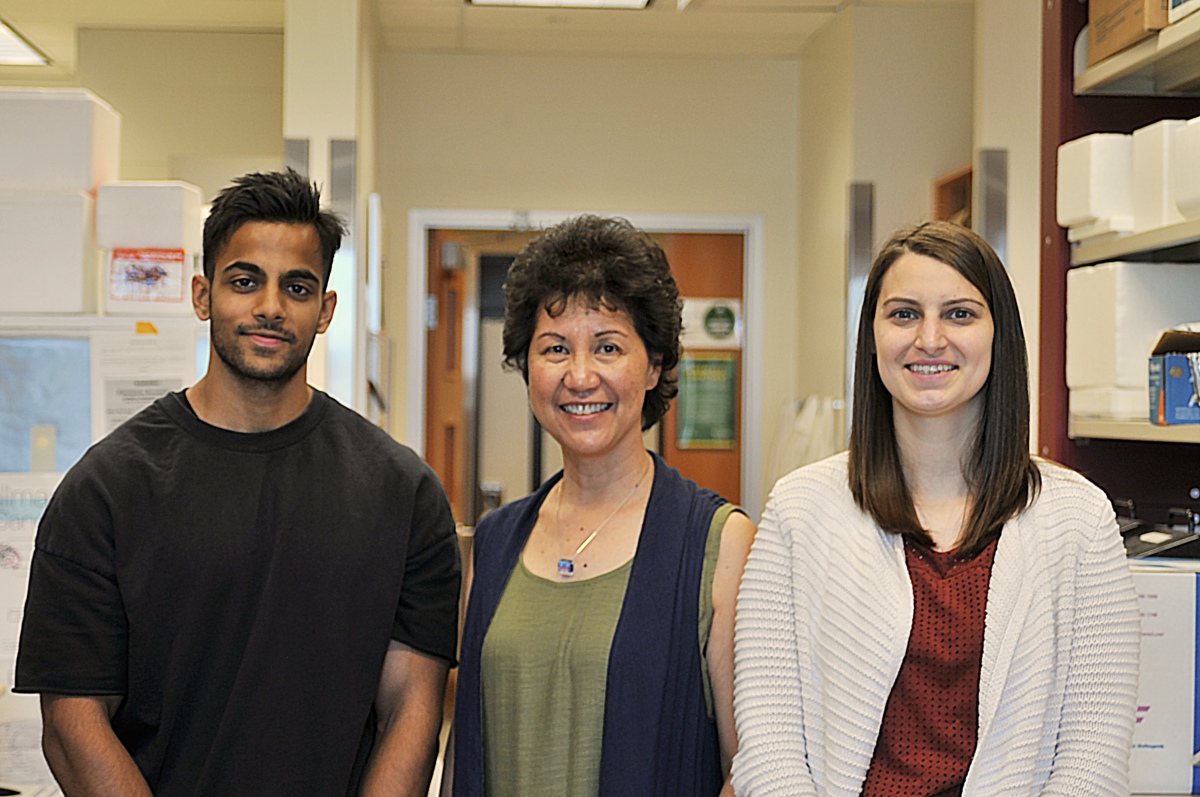
Judith Hugh (centre) with lab members Nishaka William and Lacey Haddon. The CRINA member and professor in the Department of Laboratory Medicine & Pathology is examining the role that estrogen has in the treatment of estrogen receptor positive (ER+) breast cancer.
Judith Hugh is one of the University of Alberta's leading lights in breast cancer research. A professor of anatomical pathology, and a member of both the Cancer Research Institute of Northern Alberta (CRINA) and the Women and Children's Health Research Institute (WCHRI), Hugh and her team are working to change the way clinicians treat breast cancer.
Hugh, also the first recipient of the Lilian McCullough Research Chair, is examining the role that estrogen has in the treatment of estrogen receptor positive (ER+) breast cancer. Her research may just upend conventional thought on the best treatment for as many as 50 per cent of all breast cancer patients.
Q: How long have you been at the U of A and what has been your career trajectory?
I started in 1990 and was originally at the Cross Cancer Institute as a breast review pathologist. So I would review the slides on the breast cancer patients prior to treatment for radiation or chemotherapy. I did that for 17 years and got to know the oncologists, the cancers, the pathologists in the zone and actually started doing research almost right off. I found I could only push slides for so long and then I started wanting to know more.
Q: What's the focus of your lab right now?
We are interested in ER+ breast cancer. It is one of the two main subtypes and it accounts for about 80 per cent of all breast cancers. A lot of people aren't interested in it because they feel it has been solved. But what we're doing now is trying to develop a better diagnostic to determine which of those positive patients are really going to respond well to the therapies that are currently available.
The standard practice is to treat all women with ER+ breast cancer with anti-estrogenic drugs. Even though it is known that there are two types of ER+ breast cancers, it is commonly thought that estrogen feeds both ER+ cancers. That's why women are told not to take hormones after menopause. But we think that estrogen actually kills one type of ER+ cancer, the most common type. If this is the case, then about half of all breast cancers can be treated with estrogen.
Q: How have your efforts been helped along the way?
I was appointed as the endowed Lillian McCullough Chair in Breast Cancer Surgery in 2012. The next year we received a $1-million grant from the Canadian Breast Cancer Foundation to study microRNA.
We were looking at microRNA to see if there was anything that could predict prognosis and there was nothing. Nothing. We were one and a half years into the grant and it was horrible. We had to write a progress report and it was, 'I don't think this is going to work.' But just at that time we had started doing the estrogen receptor work and I said, 'But I do have this work going on,' And I'm pleased that we were allowed to continue on that new path of investigation.
Since then, we've essentially been able to do exploratory, investigative, results-driven research. And that is so rare. It was, 'We found something, let's move in that direction. We found something else, let's move in that direction.' It's a little slower because we don't actually know where we're going, but I think that's real research. That kind of research is great because big findings are often driven from it.
There are thousands of labs studying human epidermal growth factor receptor 2 (HER2) breast cancer and they have mega funding and are doing things that no small researcher could ever hope to compete with. So it's because we have the funding that we do and we're in an area where no one else is looking that we have the opportunity to do something neat.
Q: How does your affiliation with the Cancer Research Institute of Northern Alberta (CRINA) help further your work?
You know, I think CRINA is the way to go. It institutionalizes a cooperation between cancer researchers, which I fully support. So right now there are university researchers that don't have that connection and this actually gives them the housing to start forming those links. That's huge.
Q: What's next in your research?
We have an experiment called 4C. It stands for circular, chromatin, configuration capture. So it's trying to look at how a particular region in the genome will interact with the rest of the genome.
We picked some candidates out of clinical trial data and are trying to run 4C on those candidates. If we can use those candidates to differentiate between the two subtypes of estrogen receptor positive breast cancer then it would be pretty essential toward establishing a diagnostic. Over the next year we're really pushing to complete the 4C experiment and develop a diagnostic that we can start testing on actual patient samples or move into the clinic.
Judith Hugh and her team's research have also been funded by generous supporters of the Lois Hole Hospital for Women through the Women and Children's Health Research Institute.